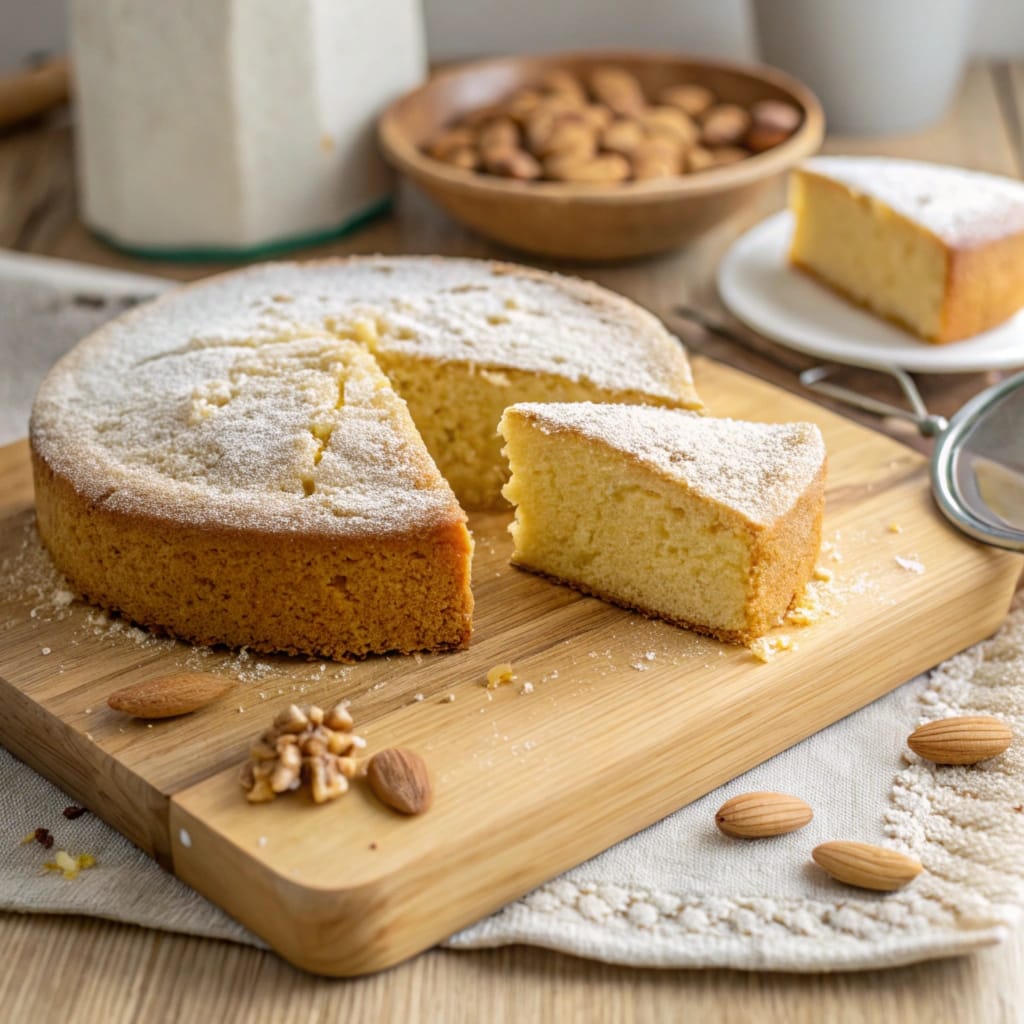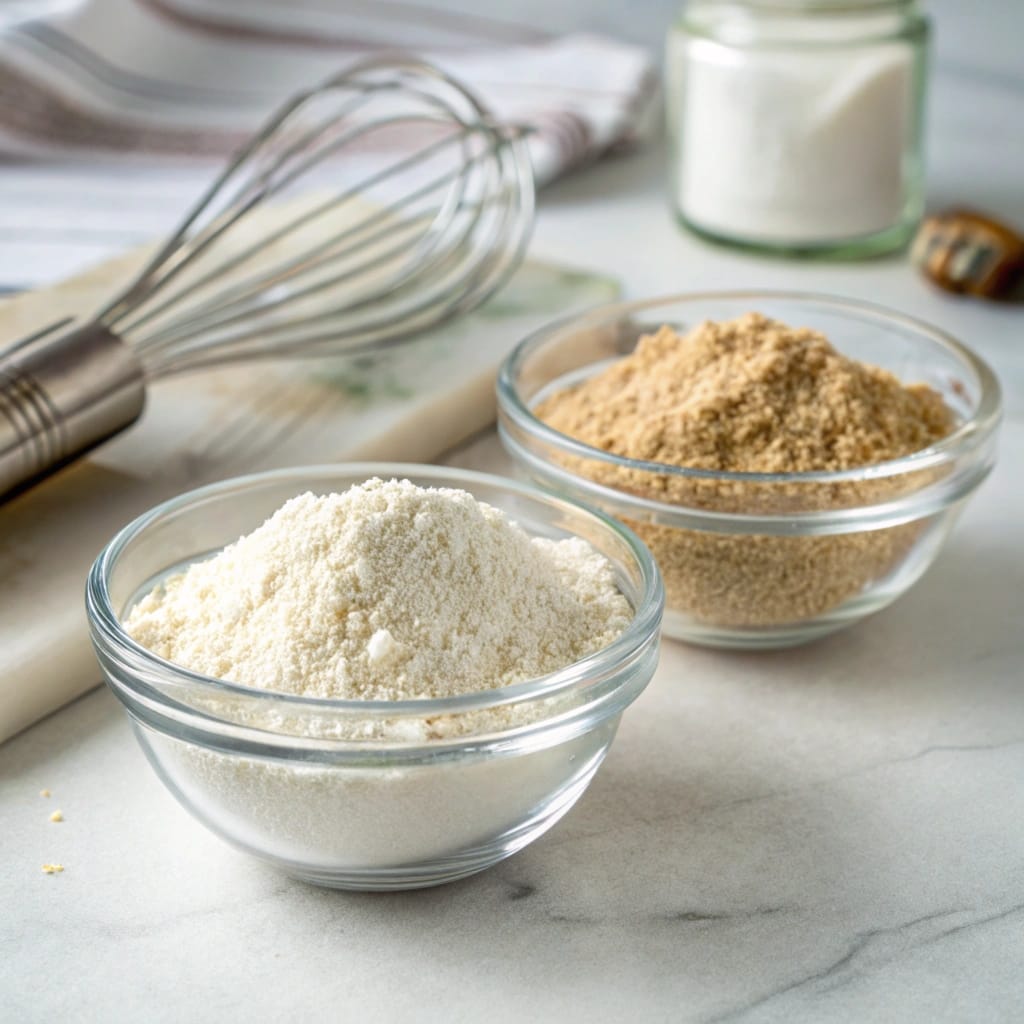Baking with almond flour is a game-changer for gluten-free, low-carb, and paleo diets. However, unlike wheat flour, it’s not a simple 1:1 swap. Its unique properties, like higher moisture retention and lack of gluten, impact the taste, texture, and structure of baked goods.
To master almond flour baking, you’ll need to understand how it behaves differently. With the right techniques, you can create soft cookies, moist cakes, hearty bread, and flaky pastries that rival wheat-based treats.
This guide will reveal essential secrets, including substitution tips, binding techniques, and ways to avoid dense or crumbly textures. Whether you’re new to gluten-free baking or a seasoned pro, you’ll gain the confidence to bake with almond flour like an expert.

Table of contents
Understanding Almond Flour
What is Almond Flour?
Almond flour is a finely ground powder made from blanched (skin-removed) almonds. Unlike almond meal, which contains the skins, almond flour is smooth, light, and pale in color. The process of making almond flour involves boiling almonds to remove their skins, drying them, and grinding them into a fine, flour-like consistency. This fine texture makes it ideal for recipes that require smooth batters or doughs, like cakes, cookies, and bread.
Nutritional Benefits of Almond Flour
Almond flour is prized not only for its baking versatility but also for its impressive nutritional profile. It’s naturally gluten-free, grain-free, and lower in carbs than wheat flour. Here are some of its top health benefits:
- Rich in Healthy Fats: Almond flour is high in monounsaturated fats, which promote heart health.
- Low in Carbs: Suitable for keto and low-carb diets, with only 2-3g of net carbs per 1/4 cup.
- High in Protein: Almond flour contains 6g of protein per 1/4 cup, making it an excellent source of plant-based protein.
- Packed with Nutrients: It’s loaded with Vitamin E, magnesium, and antioxidants that support overall health.
These nutritional benefits make almond flour a powerhouse ingredient for those seeking healthier, gluten-free baking options.
Types of Almond Flour
Almond flour comes in two main varieties: blanched and unblanched.
- Blanched Almond Flour: Made from almonds with the skins removed, resulting in a smooth, light-colored flour. It’s ideal for delicate baked goods like cakes and muffins.
- Unblanched Almond Flour: Made from whole almonds with the skin intact. It has a slightly coarser texture and a darker color. It works well in recipes where texture isn’t as critical, like cookies and bread.
Most recipes call for blanched almond flour because it produces a finer, lighter texture that’s closer to traditional flour. Unblanched almond flour, on the other hand, can create a heartier, more rustic texture in baked goods.
Unique Properties of Almond Flour in Baking
Baking with Almond Flour: Key Differences and Tips
Baking with almond flour requires a different approach than wheat flour. Its unique properties impact texture, moisture, and structure, often leading to denser cakes and crumbly cookies. Here’s how to manage these differences for better results.
Density and Texture
Almond flour is naturally denser than wheat flour due to its nut-based composition. This results in heavier, chewier baked goods.
- Impact on Baked Goods:
- Cakes and muffins have a tender, moist crumb but feel heavier than wheat-based versions.
- Cookies are chewier and may lack the crispy edge of traditional cookies.
- Pro Tip: Blend almond flour with coconut, tapioca, or arrowroot flour for a lighter texture in cakes and muffins.
Absorption Differences
Almond flour doesn’t absorb liquids like wheat flour, as it lacks the starches that trap moisture.
- Key Differences:
- Wheat flour absorbs water, creating thick batters.
- Almond flour repels water, resulting in thinner batters.
- How to Adjust:
- Add binders: Use eggs, chia seeds, or psyllium husk for stability.
- Reduce liquids: Use less water, milk, or oil than in wheat-based recipes.
- Chill dough: Chilling cookie or pie crust dough firms up the fat for easier shaping.
No Gluten Structure
Almond flour lacks gluten, a protein that gives elasticity and structure to doughs.
- How It Affects Baking:
- Cakes and muffins may be more fragile and prone to crumbling.
- Bread won’t rise as much due to the absence of gluten’s air-trapping properties.
- Solutions:
- Use binders: Add eggs, flaxseed, or psyllium husk for structure.
- Don’t overwork dough: Over-mixing weakens structure, so mix just until combined.
- Add leavening agents: Baking powder or soda helps baked goods rise.
Mastering these techniques will help you create lighter cakes, chewier cookies, and better-structured bread with almond flour.
Unique Properties of Almond Flour in Baking
Baking with almond flour is a different experience from wheat flour. Its unique properties can produce moist, soft, and flavorful treats — but only if you know how to work with it. Here’s a breakdown of almond flour’s key properties and how they impact baking.
Density and Texture
Almond flour is naturally denser and heavier than wheat flour, which affects the texture of baked goods.
- Heavier Texture: Creates a moist, dense crumb, ideal for brownies and cookies but less suitable for airy cakes.
- Moisture Retention: Almond flour retains more moisture due to its natural oils, keeping baked goods soft but sometimes too “wet.”
- Soft Crumb: The oils give baked goods a tender, soft texture, perfect for cakes, muffins, and cookies.
Pro Tip: Combine almond flour with lighter flours like coconut or tapioca flour to reduce density.
Absorption Differences
Unlike wheat flour, almond flour lacks starch, which affects how it absorbs liquids.
- Low Absorption: Batters and doughs feel wetter than expected.
- Recipe Adjustments: Reduce liquid ingredients (water, milk, or oil) or increase binders (like eggs or xanthan gum) for better consistency.
Pro Tip: Let almond flour batters rest for a few minutes to thicken naturally.
No Gluten Structure
Almond flour is naturally gluten-free, so it doesn’t offer the stretch, rise, or structure that gluten provides.
- No Stretch: Without gluten, doughs are more fragile and crumbly.
- Reduced Rise: Baked goods rise less, so use leavening agents like baking powder or whipped egg whites.
- More Fragile Structure: Almond flour cakes and cookies can break easily without binders like eggs, psyllium husk, or flaxseed.
Pro Tip: Use eggs, psyllium husk, or xanthan gum to provide structure, or blend almond flour with coconut flour for better stability.
Essential Tips for Baking with Almond Flour
Substituting Almond Flour for Regular Flour
Almond flour can’t be swapped 1:1 for wheat flour due to its density, moisture, and lack of gluten.
- Substitution Ratio: Use 1 1/4 to 1 1/2 cups of almond flour for every 1 cup of wheat flour.
- Increase Leavening: Add extra baking powder, soda, or eggs for better rise.
- Add Binders: Use xanthan gum, psyllium husk, or flaxseed to improve structure.
- Reduce Liquids: Cut water, milk, or oil by 10-20%.
Pro Tip: Follow almond flour-specific recipes for better results.
Blending Almond Flour with Other Flours
Combining almond flour with lighter gluten-free flours improves texture.
- Coconut Flour: Use 3 parts almond flour to 1 part coconut flour.
- Tapioca Flour: Adds elasticity for bread and pastries.
- Arrowroot Powder: Creates lighter cakes and muffins.
Pro Tip: Follow tested recipes since each flour absorbs liquid differently.
Measuring Almond Flour Properly
Measuring almond flour correctly is crucial for baking success.
- Don’t Pack It: Spoon flour into the cup and level it off.
- Weigh It: 1 cup = 96-100g for precise results.
- Fluff It: Break up clumps before measuring.
Pro Tip: Use a kitchen scale for accuracy.
Adjusting Liquids and Binders
Almond flour absorbs less liquid, so recipe adjustments are needed.
- Reduce Liquids: Cut water, milk, or oil by 10-20%.
- Add More Eggs: Eggs provide structure for cakes and muffins.
- Use Alternative Binders: Flax eggs, chia seeds, or psyllium husk stabilize batters.
Pro Tip: Avoid too many eggs as they can give baked goods an “eggy” taste.
Baking Temperature and Time Adjustments
Due to its high oil content, almond flour bakes faster than wheat flour.
- Lower Temperature: Bake at 325°F (163°C) instead of 350°F (177°C).
- Bake Longer: Add 5-10 extra minutes to cook through.
- Cover with Foil: If browning too fast, cover with foil.

Best Recipes for Baking with Almond Flour
Best Recipes for Baking with Almond Flour
Almond flour can be used to create chewy cookies, moist cakes, hearty bread, and flaky pastries. Unlike wheat flour, it requires special techniques for the right texture and flavor. Here are the top recipes and tips for success.
Almond Flour Cookies
Almond flour’s natural oils create soft, chewy cookies with a rich, buttery taste — perfect for chocolate chip, peanut butter, and shortbread cookies.
Tips for Success
- Use blanched almond flour for a smooth texture.
- Chill the dough for 30 minutes to prevent spreading.
- Don’t over-mix to avoid dense cookies.
Pro Tip: Add 1-2 tablespoons of coconut flour to absorb moisture and prevent flat cookies.
Almond Flour Cakes and Muffins
Almond flour produces rich, moist cakes and muffins, thanks to its healthy fats.
Tips for Success
- Don’t skip eggs — they bind and add structure.
- Use leavening agents like baking powder for a better rise.
- Reduce liquids as almond flour holds more moisture.
Pro Tip: Whip egg whites separately and fold them in to make cakes fluffier.
Almond Flour Bread
Gluten-free bread made with almond flour is dense but delicious with the right adjustments.
Challenges and Solutions
- Crust too soft: Chill dough before rolling to firm it up.
- Crust too dry: Add 1-2 tablespoons of cold water or melted butter.
Pro Tip: Roll dough between parchment paper to prevent sticking.
Other Creative Uses for Almond Flour
- Pancakes & Waffles: Fluffy, keto-friendly breakfast favorites.
- Crackers: Combine almond flour with seasonings for crispy, gluten-free crackers.
- Fried Food Coating: Swap breadcrumbs for almond flour to coat chicken, fish, or veggies.
- Energy Bites: Mix almond flour, dates, and nuts to make protein-packed no-bake snacks.
Pro Tip: Use almond flour to thicken protein bars or energy bites, giving them a smooth, cookie-dough-like texture.
Troubleshooting Baking Issues with Almond Flour
Troubleshooting Common Almond Flour Baking Issues
Why is My Almond Flour Cake Too Dense?
Almond flour cakes are often dense because of its natural heaviness compared to wheat flour.
Causes
- Too much flour: Packed flour adds excess weight.
- Not enough leavening: Leavening agents like baking powder or soda are essential.
- Lack of egg whites: Whipped egg whites create a lighter texture.
Solutions
- Measure properly: Spoon almond flour into the cup, then level it off.
- Increase leavening: Add an extra 1/4 tsp of baking powder/soda per 1 cup of almond flour.
- Whip egg whites: Fold stiff egg whites into the batter to create fluffier cakes.
Pro Tip: Blend almond flour with lighter flours (like tapioca or arrowroot) for better texture.
More Ideas for Baking with Almond Flour
If you’re inspired to bake with almond flour, here are some delicious recipes and tips from SlightRecipes that you might enjoy:
- Secret to Super Moist Cake — Learn essential techniques to keep your cakes irresistibly moist. These tips are especially helpful for almond flour cakes, as they require moisture balance for the best results.
- Easy Pastalaya Recipe — While this isn’t directly related to almond flour, the tips for balancing moisture and structure in this recipe can be applied to almond flour baking too.
- What is Chicken Salad Chick Made Of? — If you love meal prepping, pair your almond flour bread or crackers with this delicious chicken salad. It’s a healthy, tasty combination for lunch or snacks.
- Chicken Salad Chick Broccoli Salad Recipe — Serve your fresh almond flour bread or crackers alongside this nutritious broccoli salad. It’s the perfect combo for a light, satisfying meal.
- What Makes Chicken Salad Chick So Good? — Looking for the perfect side to serve with almond flour bread? This article explores why Chicken Salad Chick is so loved and gives you pairing ideas.
- What Goes with Pastalaya for Dinner? — Wondering what to serve with your almond flour bread or savory crackers? This guide offers pairing ideas that can work well for gluten-free meals too.
- Is Pastalaya Healthy? — If you’re looking for healthier recipe options, check out this post on the health benefits of pastalaya. Similar to pastalaya, almond flour recipes can support gluten-free, low-carb, or keto lifestyles.
Conclusion
Baking with almond flour can be challenging, but once you understand its unique properties, it becomes one of the most versatile and rewarding flours. With the right techniques, you can achieve soft cookies, moist cakes, hearty breads, and flaky pastries.
Key Secrets for Success
- Don’t Swap 1:1: Use slightly more almond flour and reduce liquids.
- Use Binders: Add eggs, psyllium husk, or flaxseed for structure.
- Control Moisture: Bake longer at a lower temperature to prevent sogginess.
- Store Smart: Keep almond flour in the fridge or freezer for freshness.
Almond flour’s gluten-free, low-carb, and keto-friendly benefits make it essential for health-conscious bakers. Start with simple recipes and build confidence for more advanced techniques. Happy baking!
